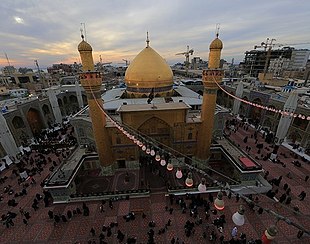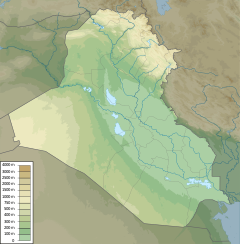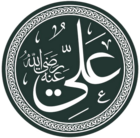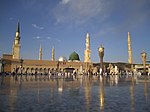Imam Ali Shrine
| Sanctuary of Imam Ali | |
|---|---|
| |
 Imam Ali Mosque, where the Shi'a believe Ali ibn Abu Talib is buried | |
| Religion | |
| Affiliation | Islam |
| Province | Najaf Governorate |
| Rite | Muslims |
| Ecclesiastical or organizational status | Mosque and Shrine |
| Status | Built |
| Location | |
| Location | Najaf |
 Location in Iraq | |
| Territory | Iraq |
| Geographic coordinates | 31°59′46″N 44°18′51″E / 31.996111°N 44.314167°ECoordinates: 31°59′46″N 44°18′51″E / 31.996111°N 44.314167°E |
| Architecture | |
| Completed | 977 CE |
| Specifications | |
| Dome(s) | 1 |
| Dome height (inner) | 42 metres (138 ft) |
| Minaret(s) | 2 |
| Minaret height | 38 metres (125 ft) |
| Shrine(s) | 1 |
| Part of a series on |
| Ali |
|---|
 |
|
The Sanctuary of Imam 'Ali (Arabic: حَرَم ٱلْإِمَام عَلِيّ, romanized: Ḥaram al-ʾImām ʿAlī), also known as the Mosque of 'Ali (Arabic: مَسْجِد عَلِيّ, romanized: Masjid ʿAlī), located in Najaf, Iraq, is a mosque which many Muslims believe contains the tomb of Caliph and Imam 'Alī ibn Abī Tālib, it is holy to both Sunni and Shia Islam. He was a cousin of the Islamic prophet Muhammad and later became his son-in-law as well. The Shias consider Ali as their first Imam, and the Sunnis regard him as their fourth Sunni Rashidun Caliph.[1] Each year millions of pilgrims visit the Shrine and pay tribute to Caliph Ali ibn Abi Talib, and the Ottoman Sultan Abdülaziz also offered gifts to the sactuary of the fourth Caliph.
According to Shi'ite belief,[2] buried next to Ali within this mosque are the remains of Adam and Nuh (Noah).[2][3]
History[]

The Abassid Caliph Harun al-Rashid built the first structure over the tomb of 'Ali in 786, which included a green dome.
The Caliph Al-Mutawakkil flooded the site in 850, but Abu'l-Hayja, the Hamdanid ruler of Mosul and Aleppo, rebuilt the shrine in 923, which included a large dome.
In 979–980, the Buyid dynasty Shi'i sovereign 'Adud al-Dawla, expanded the shrine, which included a cenotaph over the burial site and a new dome. This included hanging textiles and carpets. He also protected Najaf with a wall and citadel, while providing water from the Euphrates via a qanat.
Seljuq Sultan Malik-Shah I contributed large gifts to the shrine in 1086, as did Caliph Al-Nasir.
The vizier Shams al-Din Juvayni added facilities to serve the pilgrims in 1267, and Sultan Ghazan Khan added the Dar al-Siyada wing for the sayyids in 1303.
A fire destroyed the shrine in 1354 but was rebuilt around 1358 by Jalairid Sultan Shaikh Awais Jalayir. He also interred his father's remains, Hasan Buzurg in the courtyard. Timur ordered the restoration of the shrine after a visit to Najaf. Suleiman the Magnificent also offered gifts, which probably helped restore the shrine, after a visit in 1534. The Safavid Shah Ismail I visited in 1508, but it was Abbas I who visited Najaf twice and commissioned 500 men to rebuild the shrine in 1623. The restoration was completed by his grandson Shah Safi al-Din in 1632. This restoration included a new dome, expanded courtyard, a hospital, kitchen, and hospice, so as to accommodate the numerous pilgrims. The cenotaph was restored in 1713 and the dome stabilized in 1716.
In 1742, Nader Shah gilded the dome and minaret,[4] and this was chronicled by Nasrallah al-Haeri in his famous poem, iḏhā ḍhāmak al-dahra yawman wa jārā (Arabic: إذا ضامك الدهر يوماً وجارا).[5][6] Nader Shah's wife paid for the walls and courtyard to be rebuilt and the retiling of the iwan faience. In 1745, the iwan was rebuilt as a gilt muqarnas of nine tiers. In 1791, a raised stone floor covered the tombs in the courtyard, creating a cellar space for them.
The Ottoman Sultan Abdülaziz rebuilt the Clock Portal (Bab al-Sa'a) and the Portal of Muslim Ibn 'Aqil in 1863 and the former gilded in 1888 by Qajar Sultan Naser al-Din Shah Qajar.[7] In 1886, Sultan Naser al-Din, also repaired the dome because there were breaks in it due to the weather.
Ibn Battuta visited the shrine in 1326, noting that it was "carpeted with various sorts of carpets of silk and other materials, and contains candelabra of gold and silver, large and small." Between the three tombs, "are dishes of gold and silver, containing rose-water, musk and various kinds of perfumes. The visitor dips his hand in this and anoints his face with it for a blessing."[8] The first European visitors included Carsten Niebuhr in 1765, William Loftus in 1853, and Johann Ludwig Burckhardt in 1864.[7]:79
During the uprising of March 1991, following the Persian Gulf War, Saddam Hussein's Republican Guards damaged the shrine, where members of the Shia opposition were cornered, in storming the shrine and massacring virtually all its occupants. Afterwards, the shrine was closed for two years, officially for repairs. Saddam Hussein also deported to Iran a large number of the residents of the area who were of Iranian descent.
Religious status and precincts[]
As the burial site of Shia Islam's second most important figure,[9] this Mosque is considered by all Shi'ites as the fourth holiest Islamic site.[9][10][11][12][13][14] The Boston Globe reports "for the Muslim Shias, Najaf is the fourth holiest city, behind Mecca and Medina in Saudi Arabia and Al-Aqsa Mosque in Palestine."[15][16][17] It is estimated that only Karbala, Mecca and Medina receive more Muslim pilgrims.[15] A hadith attributed to Ja'far as-Sādiq, the Sixth Imami Shī'ite Imām, mentions the site as one of "five definitive holy places that we respect very much".[10]
The site is visited annually by at least 8 million pilgrims on average, which is estimated to increase to 20 million in years to come.[18] Many Shī'ites believe that 'Alī did not want his grave to be desecrated by his enemies and consequently asked his friends and family to bury him secretly. This secret gravesite is supposed to have been revealed later during the Abbasid caliphate by As-Sadiq.[19] Most Shī'ites accept that 'Alī is buried in Imām 'Alī Mosque, in what is now the city of Najaf, which grew around the shrine.[20]
It has also been narrated from As-Sadiq that Imām 'Alī Mosque is the third of five holy places: Mecca, Medina, Imām 'Alī Mosque in Najaf, Imam Husayn Shrine in Karbalā, and the Shrine of his daughter Fāṭimah in Qom.[21]
"God chose that land [Najaf] as the abode of the Prophets. I swear to God that no one more honourable than the Commander of the Believers [Ali] has ever lived there after (the time of) his purified fathers, Ādam and Nuh."[22]
Architecture and decoration[]
The mosque is well known for its big dome. Near its big door are two minarets. The big dome is covered in 7777 brick slabs painted in gold, there are also turquoise mosaics that cover the side and back walls.[citation needed]
Entrance to the shrine is through three main monumental portals on the eastern, northern and southern sides, called the Main or Clock Portal, al-Tusi Portal and the Qibla Portal respectively. There are two additional monumental portals, the Portal of Muslim Ibn 'Aqil, north of the Clock Gate, and the al-'Amara, or al-Faraj Portal, at the southwestern corner. A courtyard surrounds the inner shrine, while the inner shrine is linked on the west to the Al-Ra's Mosque. The inner shrine is a large cube with chamfered edges, topped by an onion-shaped dome 42 m (138 ft) in height, and flanked by twin 38 m (125 ft) tall minarets.[7]:88–91
Attacks[]
Since the invasion of Iraq by the U.S. military in 2003, there have been a number of further attacks at the mosque:
- April 10, 2003, Shia leader Sayed Abdul Majid al-Khoei, the son of Grand Ayatollah Abu al Qasim al-Khoei, was killed near the mosque. Al-Khoei had returned from exile in Britain to encourage cooperation with the U.S.-led occupation of Iraq.
- August 29, 2003, a car bomb exploded outside the mosque just as the main Friday prayers were ending. Somewhere between 85 and 125 people were killed, including the influential Ayatollah Sayed Mohammed Baqir al-Hakim, the Shia leader of the Supreme Council for the Islamic Revolution in Iraq. The blast is thought to be the work of Abu Musab al-Zarqawi.[citation needed]
- May 24, 2004, unidentified mortar fire hit the shrine, damaging gates which lead to the tomb of Imam Ali.
- August 5, 2004, Muqtada al-Sadr and the Mahdi Army seized the mosque and used it as a military base for launching attacks against the Iraqi police, the provincial government and coalition forces. The fighting was eventually ended by a peace agreement. Although the neighbouring buildings suffered considerable damage, the mosque itself suffered only superficial damage from stray bullets and shrapnel.
- August 10, 2006, a suicide bomber wearing an explosive harness blew himself up near the shrine, which killed 40 people and injured more than 50 others.
Gallery[]

An aerial view of the mosque
Ḍarīẖ covering the qabr (grave) of Imam Ali

The Golden Iwan
During Arba'een in 2015
See also[]
References[]
- ^ , Wikipedia, 2021-04-25, retrieved 2021-04-28
- ^ Jump up to: a b al-Qummi, Ja'far ibn Qūlawayh (2008). Kāmil al-Ziyārāt. Shiabooks.ca Press. pp. 66–67.
- ^ Al-Islam.org
- ^ Tucker, Ernest (1994). "Nadir Shah and the Ja 'fari Madhhab Reconsidered". Iranian Studies. 27 (1/4): 163–179. doi:10.1080/00210869408701825. ISSN 0021-0862. JSTOR 4310891.
- ^ Kirmani, Abbas (1954). Diwan al-Sayyid Nasrallah al-Haeri (in Arabic). Najaf, Iraq: Matba'at al-Ghari al-Haditha. p. 19.
- ^ "Tarikh Tathhib al-Marqad al-Alawi al-Muttahar" [The History of the Gilding of the Holy Alid Shrine]. Imam Ali Holy Shrine (in Arabic). Retrieved 2020-02-29.
- ^ Jump up to: a b c Tabbaa, Yasser; Mervin, Sabrina; Bonnier, Erick (2014). Najaf, The Gate of Wisdom. UNESCO. pp. 32, 73–81. ISBN 9789231000287.
- ^ Battutah, Ibn (2002). The Travels of Ibn Battutah. London: Picador. p. 56. ISBN 9780330418799.
- ^ Jump up to: a b Never Again! Archived 2007-08-05 at the Wayback Machine ShiaNews.com
- ^ Jump up to: a b Iran Diary, Part 2: Knocking on heaven's door Asia Times Online
- ^ Muslim Shia's Saint Imam Ali Holy Shrine - 16 Images Archived 2010-09-05 at the Wayback Machine Cultural Heritage Photo Agency
- ^ The tragic martyrdom of Ayatollah Al Hakim calls for a stance Archived 2010-09-18 at the Wayback Machine Modarresi News, September 4, 2003
- ^ Zaman Online, August 13, 2004 Archived October 28, 2006, at the Wayback Machine
- ^ Why 2003 is not 1991 The Guardian, April 1, 2003
- ^ Jump up to: a b Iraqi forces in Najaf take cover in important Shia shrine The Boston Globe, April 2, 2003]
- ^ Religious rivalries and political overtones in Iraq Archived 2009-06-11 at the Wayback Machine CNN.com, April 23, 2003]
- ^ "Miscellaneous Relevant Links" Archived 2011-10-06 at the Wayback Machine Muslims, Islam, and Iraq]
- ^ "Red tape curbs profits from Iraq religious tourism". Reuters. 2009-02-16. Retrieved May 9, 2009.
- ^ Majlesi, V.97, p. 246–251
- ^ Redha, Mohammad; Mohammad Agha (1999). Imam Ali Ibn Abi Taleb (Imam Ali the Fourth Caliph, 1/1 Volume). Dar Al Kotob Al ilmiyah. ISBN 2-7451-2532-X.
- ^ Escobar, Pepe (May 24, 2002). "Knocking on heaven's door". Central Asia/Russia. Asia Times Online. Archived from the original on June 3, 2002. Retrieved 2006-11-12.
To give a measure of its importance, according to a famous hadith (saying)—enunciated with pleasure by the guardians of the shrine—we learn that 'our sixth Imam, Imam Sadeg, says that we have five definitive holy places that we respect very much. The first is Mecca, which belongs to God. The second is Medina, which belongs to the Holy Prophet Muhammad, the messenger of God. The third belongs to our first Imam of the Shia, Ali, which is in Najaf. The fourth belongs to our third Imam, Hussein, in Kerbala. The last one belongs to the daughter of our seventh imam and sister of our eighth Imam, who is called Fatemah and will be buried in Qom. Pilgrims and those who visit her holy shrine, I promise to these men and women that God will open all the doors of Heaven to them.'
CS1 maint: unfit URL (link) - ^ al-Qummi, Ja'far ibn Qūlawayh (2008). "10". Kāmil al-Ziyārāt. trans. Sayyid Mohsen al-Husaini al-Mīlāni. Shiabooks.ca Press. p. 67.
External links[]
| Wikimedia Commons has media related to Imam Ali Mosque. |
- Official Website of the Shrine of Ali [Arabic, Persian and English]
- History of the Shrine of Ali
- GlobalSecurity.org website: past and current history of the mosque
- Mashhad Ali Amir al Muminin, An Najaf al Ashraf, Iraq[permanent dead link]
- Imam Ali Mosque
- Ottoman mosques in Iraq
- Sunni cemeteries
- Religious buildings and structures completed in 977
- 10th-century mosques
- Religious buildings and structures completed in 1500
- 15th-century mosques
- Shia mosques in Iraq
- Mosques in Iraq
- Mausoleums in Iraq
- Twelvers
- Shia shrines
- Tourist attractions in Iraq
- Safavid architecture
- Tomb of Noah
- Shrines in Iraq









